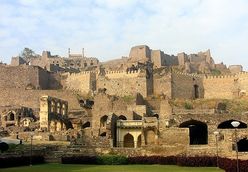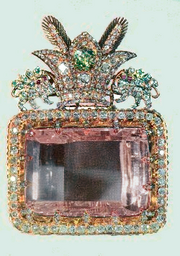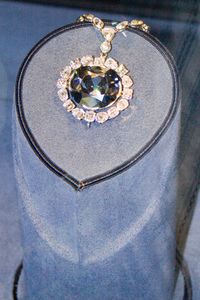Golkonda
| Golkonda | |
|---|---|
 Golkonda Fort |
|
| Town | Hyderabad |
| Country | |
| Completed | 1600s |
Golkonda, a ruined city of south-central India and capital of ancient Kingdom of Golkonda (c. 1364–1512), is situated west of Hyderabad.
The most important builder of Golkonda was Ibrahim Quli Qutb Shah Wali, the fourth Qutb king. Ibrahim was following in the spirit of his ancestors, the Qutub Shahi kings, a great family of builders who had ruled the kingdom of Golkonda from 1512. Their first capital, the fortress citadel of Golkonda, was rebuilt for defense from invading Mughals from the north. They laid out Golkonda's splendid monuments, now in ruins, and designed a perfect acoustical system by which a hand clap sounded at the fort's main gates, the grand portico, was heard at the top of the citadel, situated on a 300-foot (91 m)-high granite hill. This is one of the fascinating features of the fort.
They ruled over the Telangana region and some parts of present day Karnataka and Maharashtra.[1]
Contents |
History
The 13th century Golconda Fort was built by the Kakatiya kings.The Kakatiya’s ascent to power can be traced to the reign of the Western Chalukyas. Kakartya Gundyana, a subordinate of the Eastern Chalukyan monarch, Amma II (945 CE-970 CE), established the Kakatiya dynasty.[2] The dynasty's name comes either from its association with a town known as Kakatipura (since the kings bore the title “Kakatipuravallabha”) or from their worship of a goddess called Kakati. A temple dedicated to goddess Kakatamma exists in Warangal so Kakatipura could be another name for Warangal itself. Kakatiyas' ancestors belonged to the Durjaya family and Sudra caste.[3]
In the 16th century, Golkonda was the capital and fortress city of the Qutb Shahi kingdom, near Hyderabad. The city was home to one of the most powerful Muslim sultanates in the region and was the center of a flourishing diamond trade.
Golkonda was located 11 km west of the city of Hyderabad, Andhra Pradesh state, India (location ).
According to a legend, the fort derives its name from Golla Konda, which is a Telugu word for Shepherd's Hill. It is believed that a shepherd boy came across an idol on the hill. This led to the construction of a mud fort by the then Kakatiya dynasty ruler of the kingdom around the site.
The city and fortress are built on a granite hill that is 120 meters (400 ft) high and is surrounded by massive crenelated ramparts. The beginnings of the fort date to the 1143, when the Hindu Kakatiya dynasty ruled the area. The Kakatiya dynasty were followed by the state of Warangal, which was later conquered by the Islamic Bahmani Sultanat. The fort became the capital of a major province in the Sultanate and after its collapse the capital of the Qutb Shahi kings. The fort finally fell into ruins after a siege and its fall to Mughal emperor Aurangazeb.
After the collapse of the Bahmani Sultanat, Golkonda rose to prominence as the seat of the Qutb Shahi dynasty around 1507. Over a period of 62 years the mud fort was expanded by the first three Qutb Shahi kings into a massive fort of granite, extending around 5 km in circumference. It remained the capital of the Qutb Shahi dynasty until 1590 when the capital was shifted to Hyderabad. The Qutb Shahis expanded the fort, whose 7 km outer wall enclosed the city. The state became a focal point for Shia Islam in India, for instance in the seventeenth century Bahraini clerics, Sheikh Ja`far bin Kamal al-Din and Sheikh Salih Al-Karzakani both emigrated to Golkonda.[4]
The Qutb Shahi sultanate lasted until its conquest by Mughal emperor Aurangzeb in 1687. The fortress held out against Aurangzeb for nine months, falling to the Mughals through treachery.
Kancharla Gopanna, popularly known as Bhaktha Ramadaasu, a devout Hindu who constructed Bhadrachalm temple without informing the sultan at that time Tana Shah, was kept in a jail located inside the fort.
Diamonds


from the Golkonda mines
Golkonda was once renowned for the diamonds found on the south-east near Kollur (modern day Guntur district), Paritala (modern day Krishna district) and cut in the city during the Kakatiya reign. India Diamond#History, at that time, had the only known diamond mines in the world.
The Mines of Golkonda themselves yielded diamonds of trifling quantity. Europeans knew that diamonds were found only in these fabled mines. Golkonda was, in fact, the market city of the diamond trade, and gems sold there came from a number of mines. The fortress city within the walls was famous for diamond trade.
Magnificent diamonds were taken from the mines in the region surrounding Golkonda, including Darya-e Nur, meaning sea of light, at 185 carats (37 g), the largest and finest diamond of the crown jewels of Iran.
Its name has taken a generic meaning and has come to be associated with great wealth. Gemologists use this classification to denote a diamond with a complete (or almost-complete) lack of nitrogen; "Golconda" material is also referred to as "2A".
Many famed diamonds are believed to have been excavated from the mines of Golkonda, such as:
- Darya-e Nur
- Nur-Ul-Ain Diamond
- The Koh-i-noor
- The Hope Diamond
- The Regent Diamond
- Wittelsbach Diamond
- Reddy Diamond
By the 1880s, Golkonda was being used generically by English speakers to refer to any particularly rich mine, and later to any source of great wealth.
During the Renaissance and the early modern eras, the name "Golkonda" acquired a legendary aura and became synonymous for vast wealth. The mines brought riches to the ruling Qutb Shahis of Hyderabad State, who ruled Golconda up to 1687, then to ruling Asaf Jah of Hyderabad State, who ruled after the independence from the Mughals in 1724, until 1948,, when Hyderabad was annexed, to become an Indian state.
The Fort
Golkonda consists of four distinct forts with a 10 km long outer wall with 87 semi circular bastions; some still mounted with cannons, eight gateways, four drawbridges and number of royal apartments & halls, temples, mosques, magazines, stables etc., inside. The lowest of these is the outermost enclosure into which we enter by the "Fateh Darwaza" (Victory gate, so called after Aurangzeb’s triumphant army marched in through this gate) studded with giant iron spikes (to prevent elephants from battering them down) near the south-eastern corner. At Fateh Darwaza can be experienced the fantastic acoustic effects, characteristic of the engineering marvels at Golkonda. A hand clap at a certain point below the dome at the entrance reverberates and can be heard clearly at the 'Bala Hisar' pavilion, the highest point almost a kilometre away, this worked as a warning note to the royals in case of an attack.
The architectural grandeur of the magnificent monumental edifice is unmatched in beauty, which it has preserved brilliantly despite being more than four centuries old. As the Golconda Fort was famous for its diamond in their heyday, it is said that world famous Kohinoor diamond was from this fort. Built on a granite hill (120 metre in height), the entire massive fort is the best possible example of architectural planning and its magnificence.
The whole of the Golconda Fort complex and its surrounding spreads across 11 km of total area, and discovering its every nooks is an arduous task. Visit to the fort comprise seeing the architectural beauty in many of the pavilions, gates, entrances and domes. Parted in four district forts, the architectural valour still gleams in each of its apartments, halls, temples, mosques, and even in its stables. The graceful gardens of the fort may seem to be lost its fragrance, for which it was known 400 years ago, yet a walk in the deceased garden has to be inevitable in your schedule to explore the impression of gone glory of Golconda Fort.
Bala Hissar Gate is the main entrance to the fort located on the eastern side. It has a pointed arch bordered by rows of scroll work. The spandrels have yalis and decorated roundels. The area above the door has peacocks with ornate tails flanking an ornamental arched niche. The granite block lintel below has sculpted yalis flanking a disc. The design of peacocks and lions is a blend of Hindu - Muslim architecture.
Toli Masjid, situated at Karwan, about 2 km from the Golkonda fort, was built in 1671 by Mir Musa Khan Mahaldar, royal architect of Abdullah Qutb Shah. The facade consists of five arches, each with lotus medallions in the spandrels. The central arch is slightly wider and more ornate. The mosque inside is divided into two halls, a transverse outer hall and an inner hall entered through triple arches.
There is so much of a thought process that went in to building this gate. Few feet in front of the gate is a large wall constructed. This is to prevent elephants & soldiers (during enemy attacks) from having a proper ramp to run and break the gate.
The fort of Golconda is known for its magical acoustic system. The highest point of the fort is the "Bala Hissar", which is located a kilometer away. The palaces, factories, water supply system and the famous "Rahban" cannon, within the fort are some of the major attractions.
It is believed that there is a secret underground tunnel which leads from the "Durbar Hall" and ends in one of the palaces at the foot of the hill. The fort also has the tombs of the Qutub Shahi kings. These tombs have Islamic architecture and are located about 1 km north of the outer wall of Golconda. They are encircled by beautiful gardens and numerous exquisitely carved stones. It is also believed that there was a secret tunnel to Charminar.
The two individual pavilions on the outer side of Golconda are also major attractions of fort. It is built on a point which is quite rocky. The "Kala Mandir" is also located in the fort. It can be seen from the king's durbar (king's court) which was on top of the Golconda Fort.
The wonderful acoustic system of Golconda fort speaks volumes about the architecture of the fort. This majestic structure has beautiful palaces and an ingenious water supply system. Sadly, the unique architecture of the fort is now losing its charm.
The ventilation of the fort is absolutely fabulous having exotic designs. They were so intricately designed that cool breeze could reach the interiors of the fort, providing a respite from the heat of summer.
The Huge gates of the fort are decorated with large pointed iron spikes. These spikes prevented Elephants from damaging the fort. The fort of Golconda is encircled by a 11-km long outer wall. This was build in order to fortify the fort.It is very beautiful
Qutub Shahi Tombs
The tombs of the Qutb Shahi sultans lie about one kilometer north of Golkonda's outer wall. These structures are made of beautifully carved stonework, and surrounded by landscaped gardens. They are open to public and receive many visitors.
Trivia
- The place is also known as Mankal (The Mahakali temple located inside the fort, and the festival of Bonalu of twin cities begin here).
- René Magritte's painting Golconda was named after the city.
- In the roleplaying game Vampire: the Masquerade, "Golconda" is "a mystical state of enlightenment where... the Beast and human aspects of a vampire are in balance"[5]
Gallery
 Section of a Tent Hanging or Curtain, Golkonda, late 17th century |
A Golkonda Gate |
 Bala Hissar Gate. Note peacocks and lions above lintel. A fine example of Hindu-Islamic architecture. |
Birds' eye view of the city of Hyderabad from GolConda Fort |
See also
- Taramati Baradari
- List of sultans of Golkonda
- Afanasiy Nikitin - the first European to visit Golkonda
- Asaf Jahi
- Andhra Pradesh
- Middle kingdoms of India
- History of India
- History of Hyderabad
- Qutb Shahi dynasty
Notes
- ↑ Plunkett, R.; T. Cannon, P. Davis, P. Greenway and P. Harding (2001). Lonely Planet South India. Lonely Planet. p. 419. ISBN 1-86450-161-8. http://books.google.com/books?ie=UTF-8&hl=en&id=JmL9KqczbRYC. Retrieved 2006-03-05.
- ↑ Durga Prasad G, History of the Andhras up to 1565 A. D., 1988, P. G. Publishers, Guntur
- ↑ Ancient India, R. C. Majumdar, Edition: 8, Motilal Banarsidass, 1977, p. 377, ISBN 8120804368
- ↑ Juan Cole, Sacred Space and Holy War, IB Tauris, 2007, p44.
- ↑ http://whitewolf.wikia.com/wiki/Golconda_(VTM)
External links
- Qutb Shahi Architecture at Golconda
- Panorama of Golkonda Fort by Ravi Studios
- Photos of Golkonda Fort on HyderabadPlanet.com
- Golkonda among 7 Wonders Of Hyderabad
- Golkonda at the Islamic Monuments of India Photographic Database
- Monuments of India
- india-picture.net Several photos of Golkonda
- Golkonda photos including night ones
- Acoustics and clapping telephone described on Sound Tourism site
|
|||||||||||||||||||||||||||||||||||||||||||||||||||||||||||||
|
|||||
|
||||||||||||||||||||||||||||||||||||||||||||||||||||||||